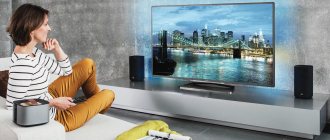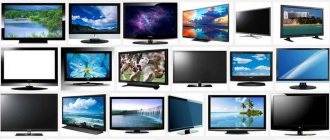At the end of this article, you can download a PDF file with all the advantages and disadvantages of the 4K TVs participating in this rating.
“Nowadays, people learn what they think on TV” - 20 years have passed, and this ironic phrase by Victor Pelevin from the novel “Generation P” has still not lost its weight. Yes, with the development of video platforms where the user can filter content, the monopoly of television was overthrown. In 2021, the number of viewers on YouTube reached 1.9 billion. This means that the Internet is not only the future, but also the present.
Matrix type Other criteria for choosing a 4K TV The best 4K TVs of 2021 4K TV LG 43UM7450: the best of the cheapest 4K TV Samsung UE43RU7410U: the best design 4K TV Xiaomi Mi TV 4S 43 T2 42.5”: the best of the ultra-budget 4K TV Samsung UE50RU7470U: the best with VA matrix 4K TV LG OLED55C9P: the best with OLED matrix
But even if we were against the propaganda of federal channels at least three times, it would be neither cold nor hot for retailers. According to analysts, in the first 6 months of 2021 alone, 4.4 million televisions were sold in Russia. And no wonder, because watching your favorite films on a monitor, even with a 22-24-inch diagonal, is not that great. Another thing is “plasma” with a diagonal of 43, 45, or even 50+ inches with high resolution and colorful colors that create a “like in a movie theater” effect. And if such a TV also has the Internet (and every model has it), what else can you dream about?
If you plan to buy a TV in the near future, we recommend that you pay attention to models with 4K resolution (3840*2160 pixels). The number of pixels in such TVs is increased by 4 times, compared with the Full HD format. The result is a crystal clear image with the highest detail and complete immersion. But there are other criteria that cannot be ignored.
Matrix type
The vast majority of 4K TVs are equipped with LCD screens based on liquid crystals. In the premium segment there are also OLED screens made on the basis of organic light-emitting diodes.
LCD TVs often use an IPS matrix, which provides a wide viewing angle without distortion. The disadvantages of IPS are weak contrast and insufficiently deep black color, which manifests itself in complete darkness and in bright light.
When looking at the characteristics of 4K TVs, in the “Matrix Type” column you will see the marketing names Nano Cell and QLED (not to be confused with OLED). These are also matrices based on liquid crystals, made on the same principle as IPS, but improved: the screen is sprayed, providing an expanded color gamut.
Separately, it is worth mentioning about 4K TVs with a VA matrix. These are also liquid crystal screens, but with an elongated vertical pixel structure. VA LCD screens provide better contrast and deeper blacks than IPS. But viewing angles are frankly weak, so the technology is rarely used for TVs, more often for monitors.
4K TVs with an OLED matrix built on the basis of organic light-emitting diodes stand apart. Compared to LCD, OLED TVs weigh less and their body is thinner. The technology provides high contrast, full color reproduction and a wide viewing angle. OLED exhibits lower brightness than Nano Cell and QLED, but not in an obvious way. There is a more serious drawback - pixel burnout. The best engineers in the world are trying to solve this problem, but so far to no avail. Well, another disadvantage of TVs with an OLED matrix is the high price.
What to look for when choosing a 4K TV
Each buyer has his own ideas about what features should be on a TV. But it’s important not to forget about the main characteristics of 4K.
Color depth
4K TVs, compared to their Full HD predecessors, support a color depth of at least 10 bits per channel. That is, modern technology is capable of displaying about 1.07 billion RGB shades. This allows you to convey numerous gradations of tones and shadows.
Comparison of color gamut of Full HD and 4K/UHDTV TVs
HDR
The basic parameters of the HDR image that modern TVs support are contained in the Rec. 2100, which provides three image resolutions:
- Full HD – 1080p;
- 4K – 3840x2160;
- currently in development 8K – 7680x4320.
Rec. The 2100 supports frame rates of 100p, 120p, 119.88p, 60p, 59.94p, 50p, 29.97p, 24p, 25p, 30p, 23.976p. Thus, you can forget about four-line options - only modern scanning is taken into account. Rec. 2100 assumes a color depth of 10 or 12 bits.
It should be noted that the AdobeRGB extended gamut, specifically designed to cover all color printer shades, is only a subset of the shade space of the already mentioned Rec. 2021 and 2100. But when processing video content, a lot of additional parameters are used to improve its brightness, clarity and color rendition. These nuances necessitated the creation of Rec. 2100.
If you look at the standards from a practical point of view, it is worth noting that Rec. 2100 and Rec. 2021 has the same color space, noticeably expanded compared to the capabilities of the previous sRGBB and BT.709 standards. The main difference between Rec. 2100 and Rec. 2021 is that the more modern version can handle basic HDR dynamic range variations.
For HDR video, with brightness levels reaching 1000 nits, the SMPTE ST 2084 – Perceptual Quantization (PQ) standard is used in the Rec.2020 color space. This technology was used as the basis for creating such popular formats:
- HDR10 with static metadata allowing color gamut adjustments;
- HDR10+ with dynamic metadata to adjust frame brightness;
- Dolby Vision is a Rec.2020 space with 12-bit color depth and a combination of dynamic and static metadata.
Visual difference between a regular picture and an HDR image
PQ has an interesting alternative - HLG (Hybrid Log-Gamma). It allows you to capture the data needed to expand the dynamic range. This ensures compatibility with standard SDR images.
Frame rate, FPS
The faster the frames change, the less blurry the picture will be when watching video content. At low FPS, blurring cannot be avoided. In this case, there will be little pleasure from watching 4K. The first models of 4K TVs had about 60 frames per second. Now this parameter has been doubled.
Diagonal
A 4K picture displayed on a medium-sized screen is often perceived by viewers located several meters from the screen as a three-dimensional image. But if you get closer to the diagonal, for example, to play a console, the difference will be noticeable.
There are no uniform recommendations for choosing a diagonal. A small TV may be appropriate for watching in the kitchen, but for a home theater the choice will be completely different. But when choosing the size of the equipment, it is worth considering at what distance from the screen the viewer will sit.
Sound
Even the most modern TV models are still far from reaching the UHDTV standard, which provides support for 24 audio channels. But 2-, 5.1- and 7.1 techniques are no longer uncommon.
Connoisseurs of high-quality sound may be interested in thin TV panels that have built-in excellent speakers with surround and ribbon drivers, as well as subwoofers. Similar models are found in the premium segment.
Screen type – OLED, QLED, IPS, TN
The leading positions in the premium TV segment are still occupied by models with an OLED matrix. This is easily explained by their high response speed, as well as decent color gamut.
QLEDs are liquid crystal displays with luminous semiconductor nanocrystals. If we compare OLED and QLED displays, the latter are slightly more affordable and have a longer service life.
If we consider not the newest OLED and QLED models, the cost of which is greatly inflated, manufacturers often do not indicate the type of matrix, limiting themselves to the term “LCD screen”. In addition, modern technologies make it possible to amplify the signal and dim the backlight. After these improvements, the choice of screen type becomes very controversial. The best solution is to go to the store and evaluate the image with your own eyes.
Operating principle of OLED TV
Smart TV
Previously, the capabilities of televisions were limited to receiving over-the-air signals. Smart TV technology is now available for sale. Owners of such a TV get free access to certain UHD content. Additionally, major manufacturers such as Panasonic, LG, Sony and Samsung provide free collections of 4K content to their customers.
If you wish, you can enter into an agreement with one of the online cinemas and enjoy videos and programs in 4K resolution. And those who want to keep abreast of all the latest cinema releases may be interested in collaborating with companies that provide access to films literally the next day after they appear in theaters. It is also possible to purchase a set-top box for the TV.
But before you make a purchase, especially if we are talking about budget 4K equipment, you should make sure that the selected model has Wi-Fi and other necessary options. Some items, such as a webcam, can be purchased separately, but only if your TV supports them. Devices are also being produced to which updated UHD standards can be added without replacing equipment.
Modern models with the Smart TV function most often have the Android platform or an operating system developed by the manufacturer. The vast majority of them allow you to use online cinemas and Internet services. The best technology is capable of interacting with mobile devices, capturing gestures and voice, and synchronizing with a smartphone.
Other criteria for choosing a 4K TV
- Diagonal 4K TV. More doesn't mean better. It is important to consider the distance to the viewer. Ideal view of 42-47" screens from 2.5-2.8 meters away. If the diagonal is 50–55 inches, we recommend moving it away to 3–3.5 meters.
- Screen refresh rate (sweep). Affects the display of dynamic scenes in films and games. It is measured in Hertz.
- Backlight. The IPS matrix uses 2 types of backlight: Direct LED and Edge LED. The first option provides high brightness and contrast, but the panel itself is thicker and consumes more power. The Edge LED backlit matrix is more expensive, but the panel is thinner. Brightness and contrast are lower than in Direct LED, but also at the same level.
- 4K TV audio system. Most TVs come with a pair of 10W speakers. If this is not enough, you can connect peripherals, or you can choose a TV with a subwoofer and multi-channel stereophony.
- Peak brightness. The higher, the better the picture is visible in strong lighting. A good level of brightness is from 250 cd/m2 or more. Unfortunately, manufacturers do not always provide information about this characteristic.
- Connectors. The set of interfaces is almost always the same - USB, HDMI, Ethernet, Miracast. But the number of USB and HDMI connectors may vary.
- Installation. As standard, the kit includes legs for installation on a horizontal surface, but sometimes they are made of flimsy plastic. On the back side there are most often holes for screwing the bracket and mounting it on the wall. The included bracket is a rarity.
Access to the Internet and digital television, Bluetooth and Wi-Fi, HDR support, speech recognition are important functions, but even ultra-budget models have them, so they are not criteria for selection.
Console, computer and 4K Ultra HD TV
A native 4K signal for games can be offered by the Xbox One X, PlayStation 4 Pro consoles, as well as, accordingly, a powerful PC. When choosing a TV “for gaming”, it is worth checking a characteristic called Input Lag. It describes how long it takes from the time an image is sent to the TV until it appears. The lower the Input Lag value, the better. In the case of dynamic games, even minimal delays can be noticeable. The optimal value would be Input Lag at a level of 20 to 24 ms - but only expensive TVs offer it.
The best 4K TVs of 2021
Russian retail is structured in such a way that all flagship equipment arrives to us with a delay. It is now mid-March 2020, and the international consumer electronics show CES took place in early January. LG, Samsung and other industry giants presented new models of 4K and 8K TVs at the exhibition, but we still don’t really know anything about them, so we can’t include them in the rating.
Let's do it differently. Let's take the best models released in 2021 that offer the best price-quality ratio. And this is probably even better: let’s check the reviews, see what problems we encounter along the way. In addition, all other things being equal, a TV released earlier will cost less, since manufacturers traditionally raise the price of flagships.
4K Ultra HD TV case, remote control and cables
First of all, it is worth checking whether the elements of the TV body are made of aluminum or ordinary plastic. Manufacturers, in the case of cheaper models, save a lot on housing elements, as well as on the remote control. When buying a TV, we usually don't think about the remote control at all - disappointment comes later.
The second element that we often forget is cables. To receive a full 4K signal, you must purchase an HDMI cable that officially supports the 4K standard and HDR technology. In theory, every HDMI cable should handle Ultra HD, but in reality it's not that simple.
4K TV LG 43UM7450: the best of the cheap ones
The first representative of the rating from LG with a screen diagonal of 43”. The screen refresh rate is 50 Hz - not the most outstanding indicator. The manufacturer did not provide data on maximum brightness, but since the TV uses Direct LED backlighting and no one swears in the reviews, we conclude that it is enough.
LG 43UM7450 is built on the basis of an IPS matrix. The matrix uses an array of RGBW color filters - not the most advanced technology, which degrades the transmission of fine color details, which is partially compensated by FRS technology, which increases color rendition from 8 to 10 bits. In RGBW, every fourth subpixel is replaced by white and is not covered with a filter, so the actual addressable resolution is not 3840 * 2160 px, but 2880 * 2160 px, i.e. It's not exactly "fair" 4K.
The TV has a fairly fast processor that provides instant response. The software part is powered by ThinQ artificial intelligence. Sound – 2 speakers 10 W each. There is the latest generation Smart TV, 3 HDMI and 2 USB connectors, Ethernet, Miracast, Wi-Fi and Bluetooth. Magic Remote included
4K Ultra HD TVs with Smart TV function
It's hard to find a 4K TV that doesn't have a built-in Smart TV platform (a kind of operating system). Contrary to popular belief, Smart TV is, first of all, access to applications that allow you to watch streaming video - from free YouTube and Vimeo to paid online cinemas. Apart from apps, movies and music, there's little that the Smart TV platform won't be of much use to you.
The best smart TV platforms are offered by (in alphabetical order) LG and Samsung. Other manufacturers often use Android TV (in particular, Sony, TCL or Philips). At the other end are all the other Smart TV platforms, which have rather niche popularity.
LG 43UM7450
good color rendition and contrast,
wide viewing angle without distortion
instant response to commands
Magic Remote included
low screen refresh rate
not quite “fair” 4K
Conclusion
Initially, we did not plan to include this model in the rating, but since the cost at the time of compiling the rating on average across stores had decreased by 7,000–8,000 rubles compared to February 2020, and now stands at 30,000 rubles, we changed our minds. The TV is just for this amount.
Price of 4K Ultra HD TVs
Finally, it's time to talk about money. How much does a “good 4K TV” cost? For models with a screen diagonal from 50 to 55 inches you will have to pay about 70,000 rubles. This is just the beginning, because high-shelf TVs, QLED or OLED receivers cost from 100,000 rubles.
Of course, there are more expensive models, but exceeding the barrier of 150,000 rubles. We leave it to the absolute movie geeks and experienced users who are willing to calibrate their TV with the help of experts to get the optimal picture.
4K TV Samsung UE43RU7410U: best design
Far from cheap, but very worthy, the Samsung UE43RU7410U with a 42.5” diagonal, IPS matrix, 100 Hz screen refresh rate and UHD Dimmind local dimming technology is suitable for those who care not only about how they show, but also what their TV looks like.
The elegant case with a white frame will appeal to those who lack light colors in the interior. The set includes a stand made of durable plastic, which is also available in white. There is a channel in the case where you can hide the wires so that nothing disturbs the idyll of minimalism.
Samsung UE43RU7410U has a powerful processor that ensures performance and image optimization when watching video content. The TV has a built-in SmartThings system for controlling smart home appliances. Owners of Apple devices will be pleased with the support for AirPlay 2.
The audio system is organized in the form of two 10-watt speakers. Nothing special, but according to reviews, the sound quality is good.
Samsung UE43RU7410U
high screen refresh rate
good brightness, detail and color reproduction
beautiful front panel and stand in white
support for smart home technology
AirPlay 2 protocol support for displaying content from Apple devices on the screen
high price
Conclusion
Samsung UE43RU7410U is not the cheapest TV. The average price tag is 40,000–42,000 rubles. It's fair to say that you can find a more affordable option with similar specs. But we couldn’t leave this design aside. Would you be willing to pay 10-15% more for a TV just because you like the way it looks? If not, and savings are more important, the following rating model is just for you.
4K TVs - what is it?
In fact, 4K is a 4096x2160 pixel image found in the film industry. But on the TV screen the picture has a different resolution - QuadHD 3840x2160. Despite this, this format also began to be designated by the capacious term “4K”.
It's a mistake to think that 4K TVs, which are also called Ultra HD, UHDTV, 2160p and UHD, stand out from their predecessors solely because of their resolution and high cost. They have many other advantages: improved color depth, faster frame rates, etc.
Comparison of all major screen resolutions
4K TV Xiaomi Mi TV 4S 43 T2 42.5”: the best ultra-budget
The first few months after its release, this 4K TV received a barrage of dissatisfied reviews. “Glitchy software”, “Wildly stupid”, “Menu freezes”. Fortunately, the manufacturer did not stand aside and released several updates.
Xiaomi Mi TV 4S 43 T2 is built on an IPS matrix with Direct LED backlighting, a maximum brightness of 250 cd/m2 and a screen refresh rate of 60 Hz. The picture is bright, detailed and moderately saturated in colors, which looks extremely nice considering the price.
There are 2 speakers of 10 W each. The sound quality is normal at low and medium volumes, but wheezing appears at maximum volumes.
Visually, this is a classic LCD panel: a body with a thin frame, legs included and VESA standard mounts on the back. The stand is quite flimsy, so it is safer to mount it on the wall.
Interfaces include Bluetooth, Wi-Fi, three HDMI and only one USB.
Xiaomi Mi TV 4S 43 T2 42.5”
one of the cheapest 4K TVs with a diagonal of 42.5”
fast response, software bugs fixed
good brightness, color rendition and detail
The speaker wheezes at maximum volume
flimsy plastic stand
only one USB output
Conclusion
Xiaomi Mi TV 4S 43 T2 is not a perfect TV, but its shortcomings are overcome by its low price. For just 25,000 rubles you get a TV with 4K resolution and without obvious flaws in screen technology.
Samsung UE50RU7470U – 50-inch 4K TV with VA matrix, LED Edge backlight, peak brightness 310 cd/m2.
In addition to the matrix, which provides high contrast and full color reproduction, the TV uses technologies that improve image quality:
- Motion Rate – to improve picture clarity;
- Micro Dimming – improves contrast, sharpens colors and deepens blacks;
- Natural Mode – automatically changes brightness when ambient light changes.
Thanks to the use of VA technology and LED Edge backlighting, the model has a thin body. Comes in silver color. Includes a V-shaped stand made of durable plastic.
The set includes 2 speakers of 10 W each. Dolby Digital Plus technology is used to balance the dynamic range. At maximum volume, sound purity is maintained.
Interfaces include Wi-Fi, Bluetooth, AV, 2 USB and 3 HDMI.
Which screen size to choose for 4K Ultra HD
There is an easy way to choose the size of your TV for the size of your room. To determine the optimal screen size, expressed in inches, multiply the distance from the sofa to the receiver, expressed in meters, by 25.
For example, if the TV should be placed two meters away from the sofa, its screen should have a diagonal of 50 inches. In the case of UHD TVs, due to picture quality, the distance between the receiver and the sofa should be multiplied by 39. Thus, a TV at a distance of two meters from the sofa can be up to 78 inches in size, and images on a 50-inch UHD screen can be comfortably viewed narrower from a distance of one meter.
Samsung UE50RU7470U
good contrast
high peak brightness level
full color rendering
small viewing angle
Conclusion
As we have already said, TVs with a VA matrix do not have as wide a viewing angle as those with an IPS matrix. But in certain conditions they are very attractive. If you are looking for a TV for a small room, where the viewing position is opposite the intended installation location and with a slight difference in height, the VA matrix will not create problems. Moreover, high contrast and full color reproduction will be an obvious advantage over a TV with an IPS matrix.
The average price as of March is 50,000 rubles.
RGB display vs RGBW display
Over the past three years, Ultra HD TVs with RGBW (red, green, blue, white) subpixels have appeared on the market. They offer worse picture quality than RGB subpixel TVs, but are priced lower than the top models.
What does it mean? We should carefully check the specifications of the TV we are planning to buy. It is also worth considering that the quality offered by RGBW TVs is not completely sufficient for us (it is worth checking the TV before purchasing, for example in a store).
4K TV LG OLED55C9P: the best with an OLED matrix
LG OLED 55C9P with an organic LED display is the best 4K TV of 2021 according to our editors. The OLED matrix guarantees excellent color reproduction and a high level of brightness, and scanning at 120 Hz ensures a smooth transition of dynamic frames.
Support for HDR 10 and Dolby Vision provides enhanced dynamic range and expanded color space. Completing the picture is the second generation LG Alpha 9 processor, which eliminates noise, adapts brightness through artificial intelligence and converts low resolution to higher resolution.
The 4K audio system of the LG OLED55C9P TV is made in the form of two 40 W speakers and two 20 W subwoofers. Low, mid and high frequencies are well balanced. At maximum volume, sound purity is maintained.
For voice control, the LG OLED55C9P TV is set to the Google Assistant program by default. In addition, the Amazon Alexa virtual assistant is integrated, which is called by holding the Amazon Prime Video button on the remote control.
Set of interfaces: 4 HDMI, 3 USB, Ethernet, Wi-Fi, Bluetooth, Miracast.











